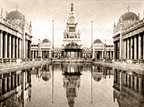 |
| |
|
|
|
|
| |
|
|
|
|
|
|
|
|
| |
|
|
| |
|
|
|
|
|
|
|
|
|
|
|
|
| |
|
|
| |
|
|
![]()
|
Architects and designers went all-out for the design of the fair's buildings. There never before had been a fair who's architectural focus had been so all-encompassing. 76 city blocks had been cleared or filled to set the stage for the exposition, and its final size was 635 acres, which allowed for the hundreds of buildings that were built. Many of the buildings were constructed with a wood base (in total, one hundred million feet of lumber were used for the fair), and then covered in a temporary material called "staff" -- a combination of plaster and a burlap-type fiber, which had an easily molded and sculpted texture. Although designed to only last for the year, the material was able to retain good detail. The buildings had a very strict eight color pastel theme that had to be adhered to, so that the overall effect was one of complete unity between the buildings. A similar style in the 1500 sculptures and murals also enhanced the fair's theme, as well as the 30,000 imported plants, trees, bushes and flowers, including 70,000 rhododendrons. Landscape architect John McLaren (also the designer of Golden Gate Park) was in charge of the exposition's landscaping, and worked closely with the many different architects involved in the project to ensure a harmonious appearance. A tremendous amount of effort also went into the fair's lighting. GE designed the overall illumination scheme, which involved thousands of carefully hidden colored spotlights, giving the buildings a magical glowing look in the evenings. Previous fairs had used a standard more old-fashioned lighting effect where thousands of tiny lights bordered the perimeters of building walls, similar to Christmas lights on houses today. The PPIE was revolutionary in changing the way that future fairs were lit. Another lighting strategy used at this fair was the "Scintillator" -- a barge that floated out in the San Francisco Bay, packed with 48 beaming searchlights, that projected seven colors of light up into sky. This backdrop was made even more amazing by a locomotive positioned on a platform on the Bay, generating steam for the lights to reflect from. On many days, however, the locomotive wasn't necessary, due to San Francisco's natural fog that served the same purpose. The Tower of Jewels was the tallest building at the fair, which sparkled with thousands of twinkling free-hanging jewels. Inside were a variety of large painted murals, depicting allegorical scenes of such things as Balboa discovering the Pacific Ocean and the progress of the Panama Canal. The exposition was sometimes referred to as The Domed City, because of the many buildings with curved-dome tops, including the Palace of Fine Arts, Festival Hall, the Manufacturers Palace, Liberal Arts Palace, the Palace of Horticulture and the Palace of Varied Industries. The Palace of Machinery was the largest palace on the grounds, with an enormous space for demonstrating various mechanical techniques. Hearst ran a giant color press here where they demonstrated printing the Examiner newspaper. There was a very popular exhibit of submarine mines and torpedoes. All sorts of exhibits were in place showing modern America's heavy machinery, machine tools, steam, gas and oil engines, passenger elevators and hoisting apparatuses. There were also many electrical exhibits by Westinghouse and Edison. Every state in the Union had a building representing them at the exposition. Some states designed traditional conservative buildings, while some tried to use more of a flair for the original by designing buildings that conveyed a sense of what their state represented. For example, Oregon's state building was a replica of the Parthenon -- but instead of Greek marble pillars, they substituted 48 huge redwood trunks, one representing each state in the Union. Virginia's building was a reproduction of George Washington's home at Mt. Vernon, and included many pieces of furniture used by President Washington. The Ohio Building was an exact reproduction of the State House in Columbus, minus its dome. And even though there was a World War in progress, almost every major nation in the world was able to construct a representative building (see the Norwegian Building) for their country -- many which were quite exotic looking. |
||||



